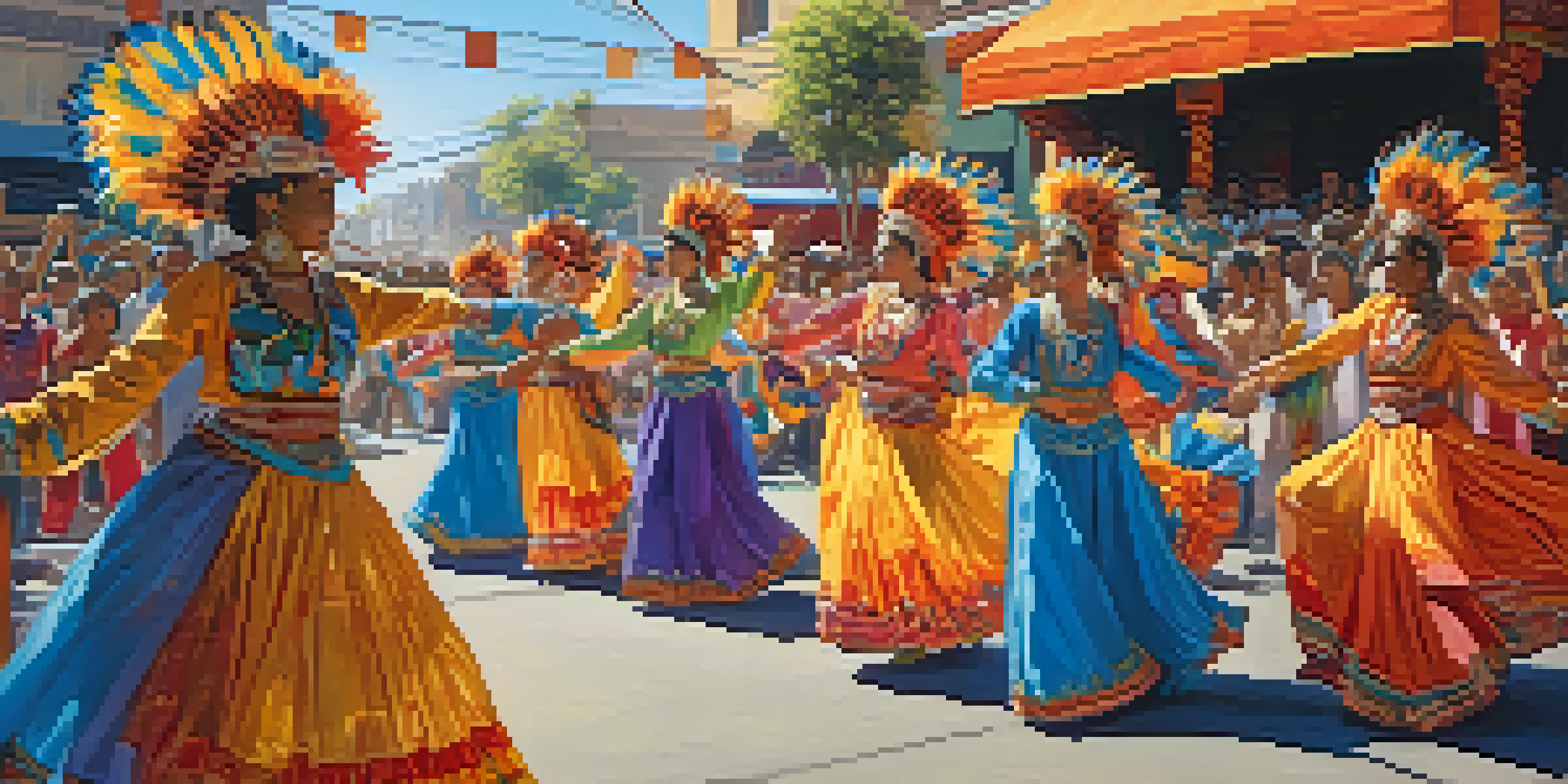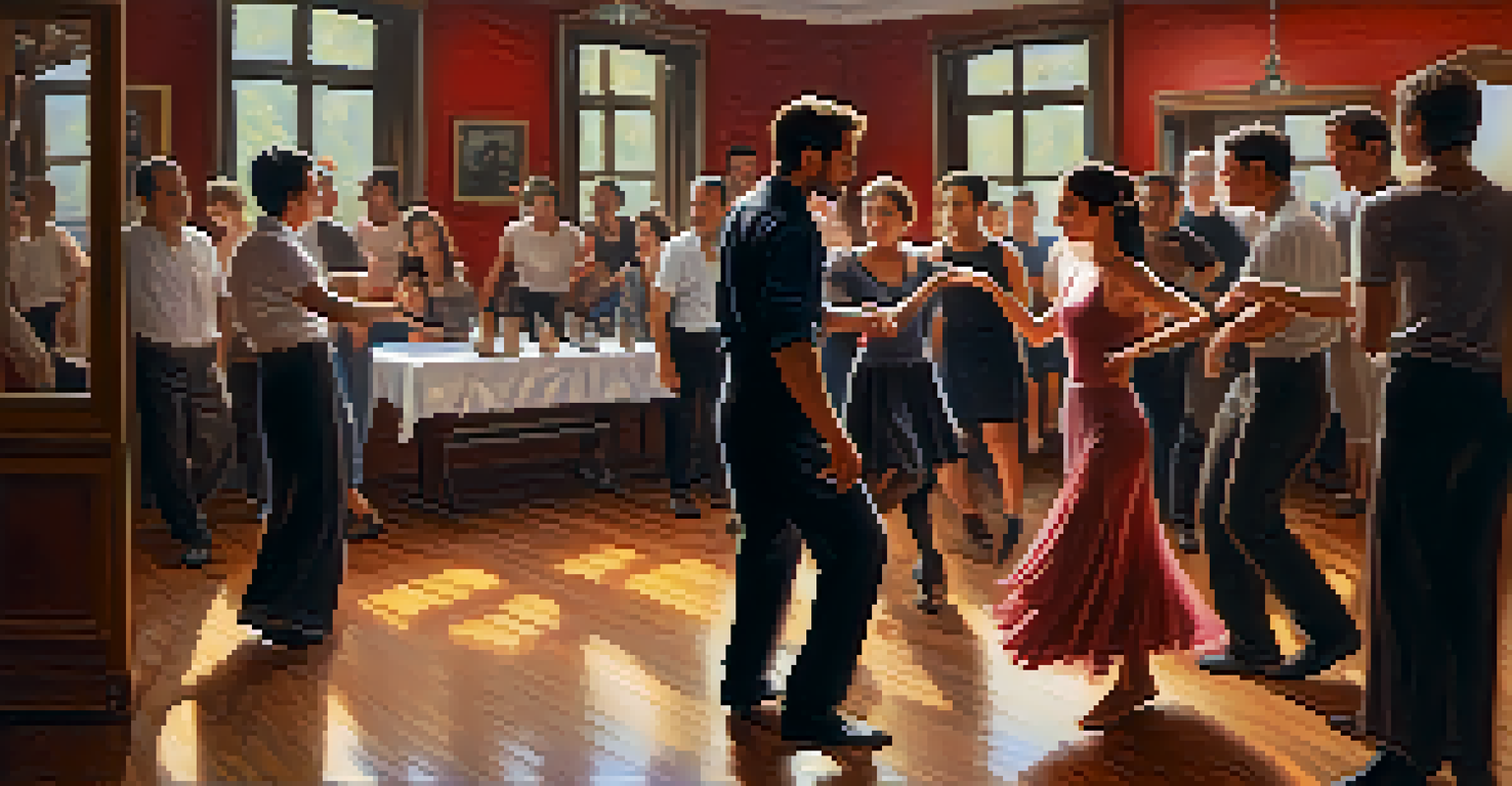Cultural Exchange Through Dance: A Tourist's Perspective

Understanding Cultural Exchange Through Dance
Cultural exchange through dance is a powerful way to connect people. It allows individuals to experience traditions, stories, and emotions that are often unique to a specific culture. When tourists engage in local dance forms, they not only learn about the art but also the history and values behind them.
Dance is the hidden language of the soul.
For instance, participating in a traditional hula dance in Hawaii offers insight into the island's history and mythology. Tourists can feel the rhythm of the islands while connecting with local performers. This immersive experience goes beyond simply observing; it fosters a deeper understanding of cultural heritage.
Moreover, dance serves as a universal language that transcends barriers. It invites participation, encouraging tourists to step out of their comfort zones and embrace new experiences. This engagement creates lasting memories and cultural appreciation, enriching the travel experience.
Experiencing Local Dance Forms as a Tourist
One of the most enriching aspects of traveling is experiencing local dance forms firsthand. Whether it's salsa in Cuba or ballet in Russia, each dance style offers a glimpse into the soul of a culture. Tourists often find themselves captivated by the passion and energy that local dancers bring to their performances.

Taking part in dance workshops or community events allows tourists to interact with locals and learn the steps. This hands-on approach fosters personal connections and enhances the travel experience. For example, a visitor in Argentina might find joy in learning the tango, gaining not only skills but also friendships along the way.
Dance Fosters Cultural Connections
Participating in local dance forms allows tourists to experience and appreciate the traditions and stories of different cultures.
In addition to learning, these experiences often lead to cultural storytelling. Dancers share the meanings behind their movements, deepening tourists' appreciation for the art form. This knowledge transforms a simple dance lesson into an unforgettable cultural exchange.
The Role of Festivals in Cultural Dance Exchange
Festivals offer vibrant platforms for cultural dance exchange, attracting tourists from around the world. These celebratory events showcase traditional dances, inviting visitors to witness the rich tapestry of local customs. Festivals like the Rio Carnival in Brazil or the Diwali Festival in India highlight how dance can bring communities together.
The dance is a poem of which each movement is a word.
During these festivals, tourists can immerse themselves in a kaleidoscope of colors, sounds, and movements. They often find themselves swept up in the excitement, joining in the festivities and learning traditional dances alongside locals. This shared joy enhances the sense of community and cultural pride, creating a welcoming environment for everyone.
Moreover, festivals serve as a valuable opportunity for cultural preservation. As traditional dances are performed for diverse audiences, they gain global recognition and appreciation. This exchange not only honors the art form but also promotes cultural sustainability, ensuring future generations can experience these rich traditions.
Dance as a Bridge Between Cultures
Dance acts as a bridge connecting cultures, fostering understanding and empathy among diverse groups. When tourists engage with a new culture through dance, they break down stereotypes and build relationships. This bridge is vital in today's globalized world, where cultural misunderstandings can often lead to conflict.
For example, witnessing a traditional Maori haka in New Zealand can evoke respect and admiration for the indigenous culture. Tourists who participate in such experiences often leave with a renewed sense of appreciation for cultural diversity. This understanding encourages a more harmonious coexistence between different societies.
Festivals Showcase Dance Diversity
Cultural festivals provide vibrant platforms for traditional dance, promoting community engagement and cultural pride among both locals and tourists.
Ultimately, dance encourages open dialogue about cultural differences and similarities. It invites individuals to share stories and experiences, promoting a sense of belonging among tourists and locals alike. This connection can lead to lifelong friendships and a deeper commitment to cultural appreciation.
The Impact of Social Media on Dance and Culture
In the digital age, social media plays a significant role in promoting cultural dance forms. Platforms like Instagram and TikTok allow dancers to share their craft with a global audience. This exposure can inspire tourists to seek out these dance experiences during their travels, eager to engage with what they’ve seen online.
Moreover, social media enables cultural exchange beyond geographic boundaries. Dancers from different countries can collaborate and share techniques, blending styles and creating new forms of expression. This fusion not only enriches the dance community but also fosters cross-cultural understanding and appreciation.
However, while social media can enhance cultural exchange, it’s crucial for tourists to approach it with respect. Understanding the origins of a dance form and acknowledging its cultural significance is vital. This awareness ensures that cultural appreciation does not turn into appropriation, maintaining the integrity of traditional art forms.
Connecting with Locals Through Dance
One of the most rewarding aspects of dance as a cultural exchange is the opportunity to connect with locals. Engaging in dance lessons or community events allows tourists to forge relationships that transcend borders. These connections often lead to authentic experiences that go beyond typical tourist attractions.
For instance, a traveler who joins a local dance troupe may find themselves invited to family gatherings or local celebrations. These moments provide insight into everyday life and customs that are often hidden from conventional tourism. Such personal interactions can significantly enrich a tourist's understanding of the culture.
Social Media Amplifies Dance Culture
Platforms like Instagram and TikTok enable dancers to share their art globally, inspiring tourists to seek authentic dance experiences while promoting cross-cultural understanding.
Additionally, these connections can create lasting friendships. Many tourists leave with more than just memories; they carry stories and bonds formed through shared dance experiences. This sense of community fosters a deeper appreciation for the culture and encourages future travel, creating a cycle of cultural exchange.
Conclusion: The Lasting Impact of Dance on Travel
In conclusion, dance serves as a powerful vehicle for cultural exchange, enriching the travel experience for tourists worldwide. From festivals to intimate workshops, these interactions foster understanding, respect, and appreciation for diverse cultures. Tourists who embrace local dance forms often leave with memories that last a lifetime.
Moreover, the connections made through dance can lead to lifelong friendships, creating a global community united by shared experiences. As travelers continue to explore the world, the impact of dance on their journeys will resonate far beyond the steps learned or the rhythms felt.

Ultimately, cultural exchange through dance not only enhances personal growth but also promotes global understanding. As we continue to celebrate and share our unique cultural expressions, we contribute to a more harmonious world, one dance at a time.